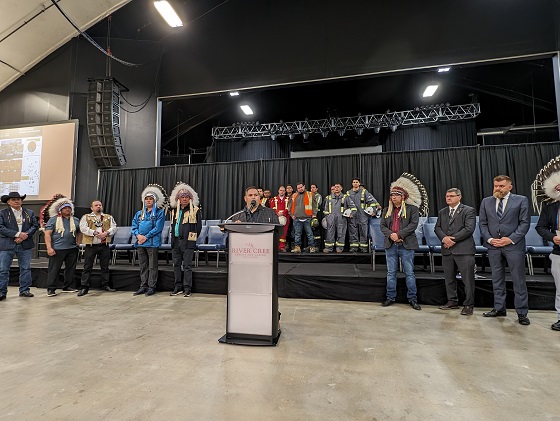Alberta
Alberta Chiefs demand Ottawa return funding for orphan well clean up

News release from Dennis Burnside, VP & Indigenous Practice Lead, Political Intelligence
Alberta Chiefs and the IRC call on Federal Government to fulfill its environmental obligations and commitments by releasing funding to First Nations
Government of Canada seeking to return $135 million in previously committed funding to federal coffers to use as savings, instead of empowering First Nations to clean up inactive and orphan wells on their lands.
ENOCH CREE NATION, AB, March 11, 2024
Chief Cody Thomas, Enoch Cree Nation, Chief Roy Whitney, Tsuut’ina Nation, and Chief Ivan Sawan, Loon River First Nation, joined with Chiefs from across Alberta today to call on the Federal Government to release unspent funding committed to the Site Rehabilitation Program (SRP) – approximately $135 million –to be utilized by Indigenous people to reclaim additional inactive and orphan wells on their lands. These funds are still in Alberta, but Ottawa is demanding them back.
On December 12, 2023, Chiefs from Treaty 6, Treaty 7, and Treaty 8 territories wrote to Minister Jonathan Wilkinson appealing to the federal government to allow the government of Alberta to place unspent SRP monies into the FNSR Program, providing much needed funding to continue the successful work that has been accomplished by First Nations, for First Nations. Without these funds, governments and industry would be leaving over 2,000 sites to be abandoned or reclaimed on First Nations lands and territories.
Chief Thomas stated: “We still have many inactive wells on our lands that need to be reclaimed properly; we estimate nearly 2,000 sites which will cost over $225 million. We acknowledge the work that has been done under the SRP but there is more to be done. This is a liability of the lessees, and the Alberta Government is holding them accountable through the Well Closure Program. However, time is not on our side. We have a very limited land base and a growing population. We must do the necessary land stewardship immediately”.
Chief Ivan Sawan stated: “Many Alberta First Nations have felt the greatest impacts of natural resource developments which have swept through our lands and ancestral territories for generations, leaving behind environmental wreckage, while being deprived of the opportunity to meaningfully participate or benefit. We are calling on the federal government to do the right thing and release these funds for the environmental and economic purposes they were intended, so that First Nations can create meaningful job opportunities, clean up our lands, and create a healthier and more prosperous future for our people.”
Chief Roy Whitney stated: “Too many oil and gas companies have simply walked away from their obligation to remediate their well sites on First Nation Lands. The SRP was a way for First Nations to have abandoned sites reclaimed. Accordingly, it was with great disappointment when we learned that the Federal Government was not going to release the remaining funds for the SRP. We fully support the request for the remaining funds being held to be released to continue the work to clean up our Lands.”
Under the previous Alberta Site Rehabilitation Program (ASRP) $130 million was allocated to 32 Alberta First Nations and Metis communities to clean up 2,145 sites. First Nations were able to abandon 988 wells and 411 km of pipelines as well as complete 793 reclamations while working on 4,188 projects. The result was a reduction of over $123 million in liability on reserves in Alberta while creating jobs, business development and training, and improving Indigenous community engagement and capacity.
The Indian Resource Council, an advocacy group that negotiated the set aside funding for First Nations, has detailed data on inactive and orphan wells on Indigenous lands. Stephen Buffalo, President and CEO of the IRC stated that the Federal regulator, IOGC, dropped the ball by failing to hold companies liable for their liabilities. He stated that First Nations can no longer depend on IOGC to get this work done.
Mr. Buffalo added: “Under Alberta’s SRP program, the government allocated more than $130 million for cleanup projects for First Nations and the Metis. So, we are doing what we can to keep that program going to maintain the success of the initial FNSRP. About 350 community members received jobs and skills training. By removing the aging wells and pipelines we can free up land to use for housing and other purposes” This is why we need the surplus funds.

A sign, from Alberta’s Orphan Well Association (OWA), identifies a non-producing and abandoned oil well near Carseland, Alberta on Sunday, July 21, 2019. Orphan wells do not have parties responsible for decommissioning or reclamation activities. THE CANADIAN PRESS IMAGES/Larry MacDougal
When SRP funding was earmarked to support Indigenous-led projects in 2021, it was celebrated that this was an area where the federal and provincial governments were in “perfect alignment”. This spirit of collaboration was good news for the environment, for Canada’s fight against climate change, and for First Nations. Alberta Chiefs are continuing to call on the federal government to rekindle this spirit of collaboration, however, Minister Wilkinson has recently stated that the federal government has “no plans to provide additional funding for the clean-
up of inactive and orphan wells.”
Alberta
Alberta takes big step towards shorter wait times and higher quality health care

From the Fraser Institute
On Monday, the Smith government announced that beginning next year it will change the way it funds surgeries in Alberta. This is a big step towards unlocking the ability of Alberta’s health-care system to provide more, better and faster services for the same or possibly fewer dollars.
To understand the significance of this change, you must understand the consequences of the current (and outdated) approach.
Currently, the Alberta government pays a lump sum of money to hospitals each year. Consequently, hospitals perceive patients as a drain on their budgets. From the hospital’s perspective, there’s little financial incentive to serve more patients, operate more efficiently and provide superior quality services.
Consider what would happen if your local grocery store received a giant bag of money each year to feed people. The number of items would quickly decline to whatever was most convenient for the store to provide. (Have a favourite cereal? Too bad.) Store hours would become less convenient for customers, alongside a general decline in overall service. This type of grocery store, like an Alberta hospital, is actually financially better off (that is, it saves money) if you go elsewhere.
The Smith government plans to flip this entire system on its head, to the benefit of patients and taxpayers. Instead of handing out bags of money each year to providers, the new system—known as “activity-based funding”—will pay health-care providers for each patient they treat, based on the patient’s particular condition and important factors that may add complexity or cost to their care.
This turns patients from a drain on budgets into a source of additional revenue. The result, as has been demonstrated in other universal health-care systems worldwide, is more services delivered using existing health-care infrastructure, lower wait times, improved quality of care, improved access to medical technologies, and less waste.
In other words, Albertans will receive far better value from their health-care system, which is currently among the most expensive in the world. And relief can’t come soon enough—for example, last year in Alberta the median wait time for orthopedic surgeries including hip and knee replacements was 66.8 weeks.
The naysayers argue this approach will undermine the province’s universal system and hurt patients. But by allowing a spectrum of providers to compete for the delivery of quality care, Alberta will follow the lead of other more successful universal health-care systems in countries such as Australia, Germany, the Netherlands and Switzerland and create greater accountability for hospitals and other health-care providers. Taxpayers will get a much better picture of what they’re paying for and how much they pay.
Again, Alberta is not exploring an untested policy. Almost every other developed country with universal health care uses some form of “activity-based funding” for hospital and surgical care. And remember, we already spend more on health care than our counterparts in nearly all of these countries yet endure longer wait times and poorer access to services generally, in part because of how we pay for surgical care.
While the devil is always in the details, and while it’s still possible for the Alberta government to get this wrong, Monday’s announcement is a big step in the right direction. A funding model that puts patients first will get Albertans more of the high-quality health care they already pay for in a timelier fashion. And provide to other provinces an example of bold health-care reform.
Alberta
Alberta’s embrace of activity-based funding is great news for patients

 From the Montreal Economic Institute
From the Montreal Economic Institute
Alberta’s move to fund acute care services through activity-based funding follows best practices internationally, points out an MEI researcher following an announcement made by Premier Danielle Smith earlier today.
“For too long, the way hospitals were funded in Alberta incentivized treating fewer patients, contributing to our long wait times,” explains Krystle Wittevrongel, director of research at the MEI. “International experience has shown that, with the proper funding models in place, health systems become more efficient to the benefit of patients.”
Currently, Alberta’s hospitals are financed under a system called “global budgeting.” This involves allocating a pre-set amount of funding to pay for a specific number of services based on previous years’ budgets.
Under the government’s newly proposed funding system, hospitals receive a fixed payment for each treatment delivered.
An Economic Note published by the MEI last year showed that Quebec’s gradual adoption of activity-based funding led to higher productivity and lower costs in the province’s health system.
Notably, the province observed that the per-procedure cost of MRIs fell by four per cent as the number of procedures performed increased by 22 per cent.
In the radiology and oncology sector, it observed productivity increases of 26 per cent while procedure costs decreased by seven per cent.
“Being able to perform more surgeries, at lower costs, and within shorter timelines is exactly what Alberta’s patients need, and Premier Smith understands that,” continued Mrs. Wittevrongel. “Today’s announcement is a good first step, and we look forward to seeing a successful roll-out once appropriate funding levels per procedure are set.”
The governments expects to roll-out this new funding model for select procedures starting in 2026.
* * *
The MEI is an independent public policy think tank with offices in Montreal, Ottawa, and Calgary. Through its publications, media appearances, and advisory services to policymakers, the MEI stimulates public policy debate and reforms based on sound economics and entrepreneurship.
-

 2025 Federal Election1 day ago
2025 Federal Election1 day agoRCMP memo warns of Chinese interference on Canadian university campuses to affect election
-

 2025 Federal Election2 days ago
2025 Federal Election2 days agoConservative Party urges investigation into Carney plan to spend $1 billion on heat pumps
-

 Alberta2 days ago
Alberta2 days agoAlberta takes big step towards shorter wait times and higher quality health care
-

 2025 Federal Election2 days ago
2025 Federal Election2 days agoFifty Shades of Mark Carney
-

 2025 Federal Election2 days ago
2025 Federal Election2 days agoCorporate Media Isn’t Reporting on Foreign Interference—It’s Covering for It
-

 2025 Federal Election22 hours ago
2025 Federal Election22 hours agoResearchers Link China’s Intelligence and Elite Influence Arms to B.C. Government, Liberal Party, and Trudeau-Appointed Senator
-

 Business2 days ago
Business2 days agoTrump raises China tariffs to 125%, announces 90-day pause for countries who’ve reached out to negotiate
-

 2025 Federal Election1 day ago
2025 Federal Election1 day agoThe status quo in Canadian politics isn’t sustainable for national unity






